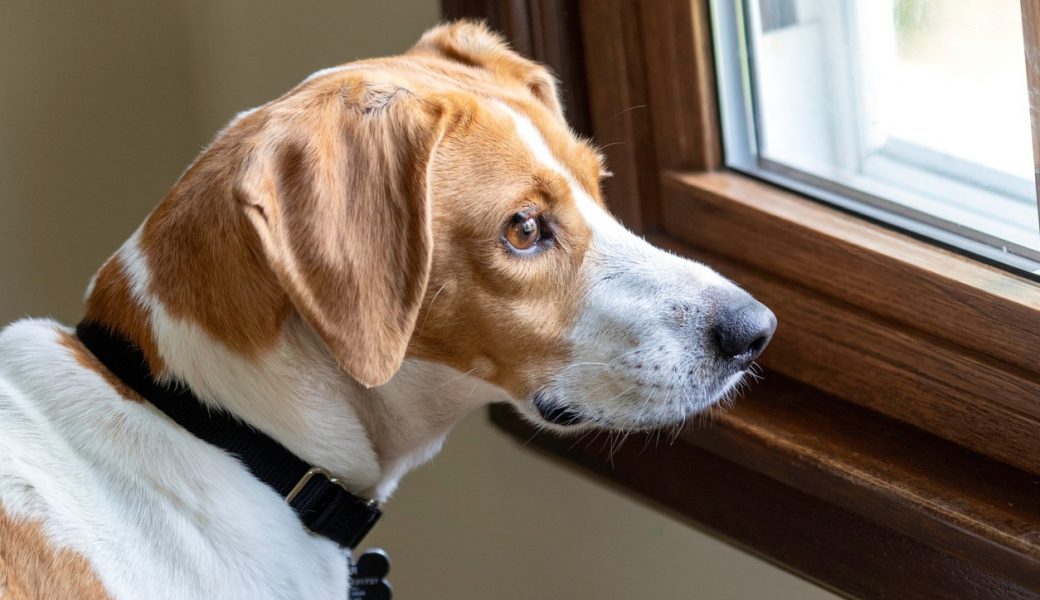
Having a loyal and affectionate dog is a wonderful experience, but it can become challenging when your furry companion struggles with separation anxiety. Separation anxiety is a common behavioral issue in dogs that occurs when they become distressed or anxious when left alone. This condition can lead to destructive behavior, excessive barking, and even physical harm to the dog. As a responsible pet owner, it’s crucial to address separation anxiety through proper training and understanding. Giving a Dog a Bone knows how to deal with separation anxiety and we’ll delve into effective techniques to train your dog to be more independent and confident when you’re away.
Separation anxiety in dogs can be caused by various factors, such as past trauma, changes in the household, or a lack of proper socialization during their early stages. Recognizing the signs of separation anxiety is the first step in addressing the issue. Common signs include excessive whining, barking, destructive behavior, pacing, and attempts to escape. Identifying these behaviors early on will allow you to start implementing appropriate training techniques.
A critical aspect of helping your dog overcome separation anxiety is creating a safe and comfortable environment. Designate a specific area in your home for your dog when you’re away, such as a cozy corner with their bed and favorite toys. Gradually introduce this space to your dog while you’re still present, allowing them to associate it with positive experiences. Avoid making a fuss when leaving or returning, as this can reinforce their anxiety.
One great way to create a comfortable space for your dog is to start with crate training. While your dog may not like the crate at first, they will soon recognize it as a safe place for them to relax. Dogs are den animals by nature, so creating a comfortable area such as a crate for them will help them deal with separation anxiety. Try putting a blanket and toys in the crate to help them feel more at home.
When leaving your dog alone, practice gradual departures and reintroductions to help ease their anxiety. Start by leaving for short periods and gradually increase the duration as your dog becomes more comfortable. While leaving, avoid long emotional goodbyes, as they can exacerbate anxiety. Upon returning, greet your dog calmly and refrain from overstimulating them with attention immediately. This is extremely important as separation anxiety forms by being too close to you all the time.
Dogs often pick up on cues that indicate you’re about to leave, such as picking up keys, putting on shoes, or grabbing a bag. To help your dog become less sensitive to these cues, practice them throughout the day without actually leaving. This desensitization process will help diminish the association between these cues and your departure, reducing their anxiety when you do eventually leave.
Eventually, these cues will become part of normal life for them and they will no longer feel the anxiety as strongly. If you have crate trained your dog, they will often go to the crate when you are ready to leave as that is where they will be most comfortable.
Positive reinforcement is a powerful tool in training dogs. Reward your dog’s calm behavior when you leave and return home. Offer treats, praise, or a favorite toy to positively reinforce their independence and make the experience more enjoyable. This will help create a positive association with your absence and build their confidence.
Interactive toys and puzzle feeders can be beneficial in keeping your dog mentally stimulated and distracted while you’re away. These toys provide a fun challenge that keeps their mind engaged, reducing boredom and anxiety. Before leaving, present these toys to your dog, making them a positive part of their alone time.
Regular exercise and mental stimulation are crucial in preventing anxiety in dogs. Engage your furry friend in daily walks, play sessions, and training exercises to tire them out physically and mentally. A tired dog is less likely to experience anxiety and will eagerly anticipate some rest while you’re away.
If your dog’s separation anxiety persists despite your efforts, consider seeking assistance from a professional dog trainer or animal behaviorist. They can provide personalized guidance and training techniques tailored to your dog’s specific needs. In severe cases, your veterinarian might also recommend behavior-modifying medications to support the training process.
Training an independent and confident dog is a journey that requires patience, understanding, and consistent effort. By creating a secure environment, implementing gradual departures, using positive reinforcement, and providing mental stimulation, you can help your furry companion overcome separation anxiety. Remember, every dog is unique, and what works for one may not work for another. Be adaptable and willing to adjust your training methods as needed. With your dedication and love, you can guide your dog toward a happier, more relaxed state when left alone. If you need help dealing with dog separation anxiety, contact Giving a Dog a Bone today!